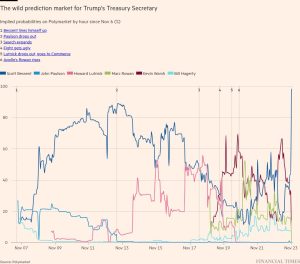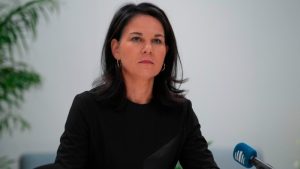What is the ECB’s outlook for Eurozone interest rates?
Stay informed with free updates
Simply sign up to the Global inflation myFT Digest — delivered directly to your inbox.
Investors are likely to be following the European Central Bank meeting on Thursday for its outlook on Eurozone interest rates, after the market was forced to radically rethink its forecasts in recent weeks.
The ECB is now overwhelmingly expected to cut the rate on its key deposit facility by 0.25 percentage points, to 3.25 per cent, at the two-day meeting in Frankfurt. But that outlook is a marked contrast to the consensus after September’s meeting.
Last month the central bank opted to cut borrowing costs for a second time this year, to 3.5 per cent. However the firm consensus among economists was that it would hold steady in October and only move again in December.
That view changed as a steady drip of weak economic data for the bloc pointed to shrinking economic activity, especially in Germany, its largest economy.
Eurozone inflation fell more than expected to 1.8 per cent in September — the lowest level in more than three years and below the ECB’s target of 2.0 per cent over the medium term. Germany’s economy is likely to shrink for consecutive years in 2024, according to government forecasts, in what would be the longest slump in more than two decades.
The ECB is now expected to cut by another 0.25 percentage points in December, followed by several cuts of the same size early next year. Economists expect the ECB’s key deposit facility rate will fall to around 2 per cent by next summer.
However the market will also have to adjust to a change in the ECB’s communication strategy on Thursday. RBC Capital Markets told clients that rather than stressing its “meeting-by-meeting approach and highlighting that rates will stay restrictive for now”, the central bank will point out that rates are now on track to a “more neutral level.” Olaf Storbeck
Will UK inflation drop below the BoE’s target?
UK inflation data on Wednesday is likely to be the decisive factor on whether the Bank of England will speed up the pace of rate cuts this year.
Economists polled by Reuters expect annual headline inflation will show a decline to 1.9 per cent in September, from 2.2 per cent in August and July, as the falling price of crude oil eased the pressure on motor fuel prices.
That would mean headline price growth had fallen below the Bank of England’s long-term target of two per cent for the first time since April 2021. This week Andrew Bailey, governor of the Bank of England, said the bank’s rate-setters could be “a bit more aggressive” on lowering borrowing costs if inflationary pressures continued to wane.
However economists and investors are likely to focus on inflation in services, a key part of Britain’s economy. Services inflation accelerated to 5.6 per cent in August from 5.2 per cent in July, but analysts are expecting the number to decline to 5.3 per cent in September.
Ellie Henderson, an economist at Investec, said the decline in services inflation is likely to come from falling prices in restaurants, hotels, airfares and private school education.
The trend for services will help shape expectations for inflation for the rest of the year. Economists, including those at the Bank of England, expect headline inflation to rise to 2.5 per cent at the end of the year,
But Henderson warned that if slowing price growth is largely down to temporary factors such as airfares and fuel prices “then the victory party on inflation might end up being delayed for another few months.” Valentina Romei
Will US consumer activity pick up the pace?
Investors’ attention is turning to data that tracks consumer behaviour as the Federal Reserve said its policy on interest rate cuts is being driven by economic strength rather than price pressures.
Traders will be watching September retail sales figures on Thursday to see if consumer spending has strengthened further after a surprise growth of 0.1 per cent, month-on-month, in August. Forecasts compiled by FactSet suggest the headline rate will rise 0.4 per cent or 0.25 per cent after car sales, typically a more volatile number, are stripped out.
Market expectations for a series of rapid rate cuts from the Fed this year were dealt a huge blow after bumper September jobs data indicated the resilience in the US economy.
“I think retail sales and the consumer really will remain the driver (of market interest), but there is an easing of pressure given the strength of the jobs data,” said Leslie Falconio, of UBS Asset Management’s chief investment office.
Thursday’s report may however be skewed by Hurricane Helene which slammed into the US south-east late last month. Storm-affected headline numbers could present a problem in following underlying trends in data for several months, analysts have warned, with this week’s Hurricane Milton expected to make October numbers harder to parse, too.
“We’re anticipating a challenging period over the coming weeks of accurately assessing the impact of recent developments on the real economy,” Ian Lyngen of BMO Capital Markets told clients.
“Retail sales, personal consumption, GDP, and even the payrolls data could be distorted by the storms and subsequent rebuilding efforts.” Jennifer Hughes
#ECBs #outlook #Eurozone #interest #rates





